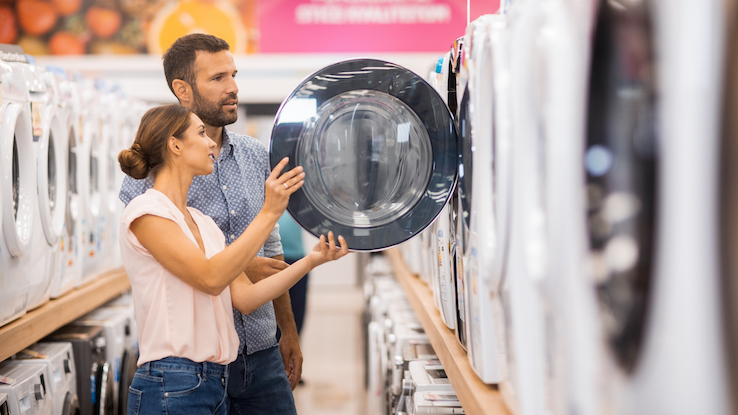
With Energy Star rebates, being green is a little bit easier. Energy Star is a government program that certifies appliances based on their energy efficiency. There are retail rebates and tax credits for choosing Energy Star-certified appliances.
How do you choose the right appliances to earn the rebates? Between the rebates and savings from using less energy, do you really save money with Energy Star appliances? Here’s what you need to know.
What Are Energy Star Rebates?
Energy Star is a government program in partnership with the Environmental Protection Agency (EPA) and the Department of Energy (DOE.) When you see the Energy Star symbol on a product, that means the product meets or surpasses the EPA’s standards for energy efficiency. Appliances and other household products that are energy efficient offer the most performance while using the least amount of energy.
Energy Star products offer even more savings because the federal government offers rebates in the form of tax credits for homeowners, builders and owners of commercial buildings who buy Energy Star products. Utility companies also offer rebates.
How Do Energy Star Tax Credits and Rebates Work?
There are two sets of tax credits that can apply to the use of Energy Star-certified appliances and fixtures in your home. These tax credits do not usually cover the total cost of the Energy Star-certified product. Rather than being for smaller appliances, like washing machines and light bulbs, these tax credits extend to people who purchase larger energy-efficient systems, like heat pumps and skylights. To apply for the tax credit, you must make improvements to a home you own. They can apply to new construction or homes that are already built.
If you have installed a geothermal heat pump, residential wind turbine, solar water heater, solar panel, residential fuel cell or biomass fuel stove since 2019, you may be eligible for the Renewable Energy Tax Credit. Under this provision, you can earn a tax credit between 22-30% of the costs of installing the Energy Star-certified system in your home, depending on the year you installed it. You can claim this credit on installations that happen up to January 1, 2024.
There is also an Equipment Tax Credit. To qualify for this credit, the applicable Energy Star-certified system must have been installed in your home before December 31, 2021. The tax credit offers up to $500 for installing or purchasing the Energy Star-certified product. The systems covered are insulation, metal and asphalt roofs, biomass stoves, air source heat pumps, hot water boilers, furnaces, fans, water heaters, advanced main circulating fans, and biomass stoves.
How to Apply for Energy Star Tax Credits and Rebates
To apply for federal tax credits related to using Energy Star appliances, use IRS Form 5695. The form has specific instructions for each tax credit offered. It explains the maximums for each type of tax credit. There are also lines to enter information about your appliances. You need to complete this form along with your income tax return in the tax year that the purchase or installation of your Energy Star appliances happened. Form 5695 also contains clear instructions for determining which tax year to claim a purchase in.
Many states, utility companies and regional initiatives also offer rebates for homeowners who use Energy Star appliances. The application processes for these rebates vary from organization to organization. Generally, it is best to keep receipts on the Energy Star appliances you purchase and any associated installation costs. Then, follow the instructions of the agency offering the rebate to claim your incentive.
How Much Can You Save With Energy Star Appliances?
In addition to helping the environment by cutting energy consumption, Energy Star products are said to save households money on utility bills. By some estimates, a household can save nearly $500 on utility bills each year by switching to Energy Star products.
Since they are energy-efficient, Energy Star appliances can last longer than ones that do not use energy wisely. For example, Energy Star light bulbs can last 15 times as long as non-energy efficient ones. These products cost less to use since they require less energy and cost less in the long run because you have to replace them less often.
Energy Star Rebate Tips
Energy Star’s Rebate Finder is an ideal tool for discovering all of the rebates you are eligible for. In addition to the tax credits that apply to all homeowners, there are also regional and local Energy Star rebate initiatives. In many areas, utility companies offer Energy Star rebates to customers installing energy-efficient appliances in their homes.
You can filter your search by ZIP code to find local rebates. You can also search by all ZIP codes to find rebates available for the whole country. Depending on where you live, locally offered rebates may offer even greater incentives to switch to appliances that save on energy than the ones offered to the whole country.
Be sure to read the instructions for any rebates carefully. Some rebates offer money back for purchasing the appliance, and some give rebates towards the installation of the appliance as well. Pay special attention to the rules for getting the rebate. Some will give you money back outright. Especially when the rebates come from third parties, you may need to take additional steps to earn it. While you do not get money when you earn a tax credit, it reduces the income taxes you need to pay. Utility companies often offer rebates in the form of monthly discounts on your bill rather than paying you.
Homeowners are wise to apply for any Energy Star rebates available in their area. You could earn money, save money and help the environment, all at the same time.





